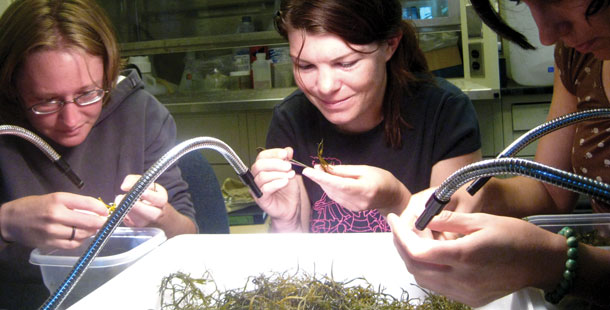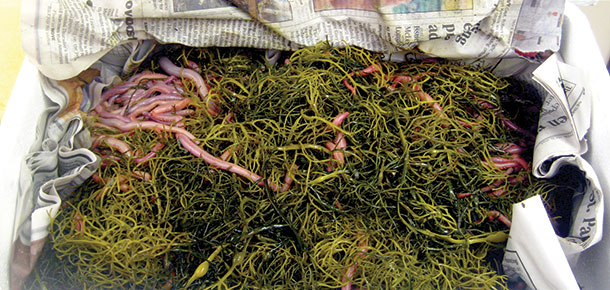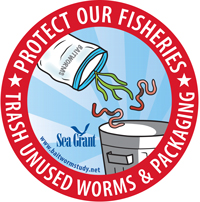Knauss legislative fellowships in Congress help build careers — and they're fun and educational. See our video and fact sheet for details.
Bait Worm Study
|
|
The Problem: Anglers in the Mid-Atlantic often use live baitworms packed in seaweed. But this poses a threat to the environment – the seaweed can carry invasive species that don’t belong here.
How You Can Help: Throw away unused worms and seaweed packaging in the garbage. This simple action will help protect fish and preserve the natural habitats where they live.
The Background: A team of university researchers is studying the bait worm industry and is working with bait worm dealers to develop solutions. You can learn more about this effort, and the researchers’ work and findings, on this webpage.
Table of Contents
- Introduction
- Our Research
- Findings
- Vectors and Vector Management
- Downloads – Print brochures and posters about this topic to share with others.
- Links – For more information
Introduction
Do you know where your live worms come from? Do you know what other plants and animals might be living in and on the seaweed in which they are packaged? Do you know how to discard your bait and the seaweed so that those organisms don’t invade and harm your fishing waters?
These are the subjects of this research project being conducted by university-based, state Sea Grant programs from North Carolina to New Jersey in collaboration with researchers at the Smithsonian Environmental Research Center, the University of Maryland at College Park, and the University of Wisconsin at Madison.
Specifically, we are studying the bloodworm industry, which ships millions of worms per year from Maine to the Mid-Atlantic and other places around the world for use by anglers. The worms are shipped packed in seaweed, which carries many potentially invasive organisms.
Our goal is to understand the risks posed by the transportation and disposal of these live worms and their seaweed packing material and to explore alternative methods of packing (i.e., alternative packing materials or washing the seaweed) in order to prevent the spread of potentially invasive species "hitchhiking" along this trade distribution pathway or "vector."
Anglers can help keep invasive species out of our waters by throwing away unused worms and seaweed packaging in the garbage.
Our Research
Rather than focusing on specific individual species that pose threats to the environment, our  research focuses on managing potential pathways or vectors that carry numerous species, any of which may be introduced. Managing many species collectively by preventing introductions from occurring in the first place is more cost effective and protective of the environment than trying to remove a species after it invades our waters. We chose to focus on the live bloodworm trade vector in particular because it lends itself to a “cradle to grave” analysis that enables scientists to understand which and how many hitchhiking organisms are being transferred from the source (Maine) to the recipient region, in this case, the Mid-Atlantic. What we learn about this vector can help prevent the introduction of invasive species by this and other similar pathways.
research focuses on managing potential pathways or vectors that carry numerous species, any of which may be introduced. Managing many species collectively by preventing introductions from occurring in the first place is more cost effective and protective of the environment than trying to remove a species after it invades our waters. We chose to focus on the live bloodworm trade vector in particular because it lends itself to a “cradle to grave” analysis that enables scientists to understand which and how many hitchhiking organisms are being transferred from the source (Maine) to the recipient region, in this case, the Mid-Atlantic. What we learn about this vector can help prevent the introduction of invasive species by this and other similar pathways.
In our research, we had three goals:
- To understand the biology and ecology of the species that naturally live in the seaweed used as packing material for bloodworms
- To understand the ways in which the vector is shaped and affected by human choices
- To understand how changes to the vector affect the people who are involved in it
Analyses
Biology
The biological team consisted of researchers from the Smithsonian Environmental Research Center (SERC) who conducted a detailed analysis of the organisms that live in this seaweed, which is used to pack and ship bloodworms from Maine.
The seaweed is a type of algae with the scientific name Ascophyllumm nodosum, also known as "wormweed." The alga commonly grows in shallow coastal areas in Maine. The researchers wanted to know how many species 1) live with the seaweed naturally, 2) of these, how many get packaged with bloodworms and sent on to the Mid-Atlantic and other locations, and 3) how many hitchhikers survive the trip and can be introduced to and possibly invade Mid-Atlantic waters if the wormweed packing material is thrown into the water.
 Using a multi-stage approach, the researchers collected samples of the seaweed from multiple sources: from the intertidal saltwater marshes in Maine where it is harvested, from bait boxes shipped directly from the Maine distributors to SERC, from bait boxes purchased from Mid-Atlantic distributors, and from bait bags purchased at local bait shops.
Using a multi-stage approach, the researchers collected samples of the seaweed from multiple sources: from the intertidal saltwater marshes in Maine where it is harvested, from bait boxes shipped directly from the Maine distributors to SERC, from bait boxes purchased from Mid-Atlantic distributors, and from bait bags purchased at local bait shops.
The researchers used a painstaking process to carefully sort through the seaweed, set aside any organisms found, and identify and count those organisms. As a result, the researchers were able to understand 1) the identity and numbers of organisms that live naturally on the seaweed, 2) the identity and numbers of organisms that are accidentally included with shipments of bloodworms, 3) the identity and numbers of organisms that survive the trip from Maine to the Mid-Atlantic. Most of the organisms identified were marine invertebrates (e.g., snails, crabs, isopods) as well as some insects and plant and algae material. Seawood from bait boxes was also analyzed by researchers from Old Dominion University for the presence of Vibrio bacteria, including the strain that causes human cholera.
In addition to surveying the organisms present in the seaweed packing material all along the vector (from source to destination), the researchers conducted a series of experiments to investigate whether certain handling techniques were effective for removing or killing hitchhiking organisms. Seaweed was soaked in baths of water of different salinities (e.g., fresh water, high salinity). By rapidly changing the salinity of the water, many of the hitchhikers would undergo osmotic shock that would weaken or kill them. Since the seaweed is very hardy and able to live across a wide range of salinity, it would not be harmed by the treatment and would continue to function well as a packing material for the worms. This approach, if effective, could serve as a low-cost management technique that would not put wormweed harvesters in Maine out of work. Alternatively, other packing materials, such as moist newsprint paper, are being used by some more environmentally minded baitworm distributors.
Social Science
Working alongside the biological team was a team of social scientists from the University of Maryland who were interested in how the bloodworm industry is structured and has developed. The social scientists were also interested in people’s beliefs and values about the worms, seaweed, and invasive species and how these views might influence how people would respond to changes in shipping methods. The researchers conducted interviews with people in the industry – worm and seaweed harvesters, dealers, bait store staff and owners, etc. – and surveyed thousands of anglers in the Mid-Atlantic region. Their goal was to find the best way to work with the industry and consumers to make necessary changes that would prevent the introduction of invasive species through this vector, while taking into consideration economic and livelihood factors for participants in this industry.
An Inter-disciplinary Approach to Building Awareness
Important to this study was our recognition of the importance of the live bloodworm bait industry for both the people of Maine and for the many anglers who fish in Mid-Atlantic waters and beyond. The findings from this research are intended to inform the industry and anglers about this vector and to contribute to their responsible stewardship of the aquatic systems they care about.
Combining the biological and the social science approaches to the project, the researchers identified possible approaches to reduce the transmission of invasive species from Maine to the Mid-Atlantic along this vector. In Maine, at the beginning of the supply chain, researchers from SERC, the University of Maryland, and the University of Wisconsin talked with people in the industry to understand whether and how the seaweed washing methods studied by the biologists might be adopted by the baitworm dealers. The researchers also looked into alternative packing materials that would serve the same function as the seaweed – keeping the worms in peak health for the long trip from Maine to the Mid-Atlantic – without carrying potentially invasive species. Improving education about aquatic invasive species and changing practices at this level are long-term goals, but with continued interest from the researchers and an ongoing engagement with the industry, these changes could substantially reduce the risk of transmitting invasive species by this vector.
At the other end of the supply chain, the researchers are working with anglers and bait stores in the Mid-Atlantic region to get out the word about the risk posed by this vector. Using information gathered from the biological and social science research, Sea Grant Extension agents and researchers from Maryland and Wisconsin are developing a social marketing campaign. This effort would inform anglers about the threat of invasive species and instruct them on how to properly dispose of worms and seaweed. The research shows that many anglers already discard their seaweed and unused worms in the garbage rather than in the water. The vast majority are concerned about the threat of invasive species and are willing to throw unused worms and seaweed in the garbage. However, few are aware of the invasive threat posed by this bloodworm-seaweed vector, so getting out the word would go a long way toward decreasing the risk of invasion. Bait stores play an important role in this process. As experts and opinion leaders in the world of fishing, they can contribute substantially to informing their customers about the issues and instructing them on proper disposal of worms and seaweed.
More About Vectors and Vector Management
What Is a Vector?
Invasive organisms need some way to get from one place to another. In the past, the only mode of transportation was natural – for example, walking, swimming, or flying to new places or being carried by rivers, ocean currents, or storm events. However, with increased human population growth, movement, and commerce, new forms of human transportation have enabled other organisms to “hitch hike” from one place to another. Add to this the increase in trade between different countries and the development of new methods for keeping perishable goods from spoiling, and the opportunities for organisms to be introduced outside their native ranges to new regions where they might become invasive are increasing. These pathways are known as vectors, and a single vector may be capable of spreading many different kinds of organisms to many different places.
Why Is Vector Management Important?
The typical approach to managing invasive species is to focus on an individual species that have already invaded or is known to pose an invasive threat to a particular area. Because this is a reactive approach that is operating on a species by species basis, it tends to be less effective than taking a more proactive approach which instead focuses on the operation of the vector itself. By controlling how vectors operate (i.e., reducing their potential to move organisms) the
transport of vast numbers of potential invaders can be prevented. An added benefit to managing the vector rather than individual species at the point of invasion is that it can translate into protection for all potential destinations. An ounce of prevention is worth a pound of cure.
Downloads
You can help spread the word: keep invasive species out of our waters by throwing away unused worms and seaweed packaging in the garbage. These informational publications describe this message. Print and share them to spread the word.
North Carolina: Brochure | Poster
Pennsylvania: Brochure | Poster
Links
Marine Bait Worms as a Potential Vector of Non-Native Species, Connecticut Sea Grant and the University of Connecticut
Mitten Crab Watch, Marine Invasions Research Lab, Smithsonian Environmental Research Center
Invasive Species in Maryland, Maryland Department of Natural Resources
Invasive Species' Angler's Log, Maryland Department of Natural Resources. Share information about species of invasive fish that you catch.
Invasive Species of Concern in Maryland, Maryland Invasive Species Council
For More Information About This Project
Contact Jenna Clark, Program Assistant, Maryland Sea Grant
.jpg)

